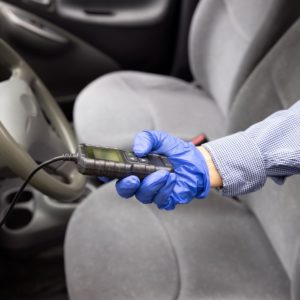The mass air flow (MAF) sensor measures the amount of air volume delivered to the engine. Typically found in many fuel injection systems, the MAF sensor works with the powertrain control module to deliver the right amount of fuel to the engine.
If the MAF sensor fails, on-board diagnostics will log a P1101 engine code.
What Does the P1101 Code Mean?
Diagnostic trouble code (DTC) P1101 stands for “MAF sensor out of self test range.”
The MAF sensor works with the PCM to determine the amount of fuel needed and base pulse-width numbers.

This means that the duration of the injector’s operation will depend on the mass of incoming air.
The MAF sensor also acts as a backup throttle position (TP) sensor in case the latter fails.
A problem with the MAF sensor will leave the fuel calculation process to the PCM, which will be based on the throttle position and engine speed.
MAF sensor issues will also cause the engine computer to log a P1101 code.
For more technical information about fuel injection and airflow, read our advanced discussion about the MAF and MAP sensors.
Note: The definition of code P1101 may be different depending on the vehicle manufacturer. Consult the appropriate repair manual or repair database for the exact code definition.
P1101 on Some Chevrolet Vehicles
The P1101 code can appear in some Chevrolet Cruze vehicles. In the 2017 model, this code translates to “Intake Air Flow System Performance.”
The PCM typically sets this DTC when the electronic control module detects that the actual airflow rate is greater than the calculated airflow.
What are the Common Causes of the P1101 Code?
- Damaged MAF sensor
- Corroded or faulty MAF sensor wiring harness
- Clogged MAF sensor
- PCM issues

What are the Common Symptoms of the P1101 Code?
- Illuminated check engine light
- Erratic idling upon startup
- Stalling
- Reduced power while driving
How to Diagnose the P1101 Code
DTC P1101 is a powertrain code that can be logged in various models. However, keep in mind that the steps for diagnosis and repair can vary, depending on vehicle specifications.
If you’re not familiar with the process of diagnosing trouble codes yet, it’s best to leave the job to the pros.
But if you think you can handle the task on your own with minimal supervision, then you can go ahead and work on your vehicle.
Here’s a short video you can watch to get an idea of what the process usually involves.
How to Fix the P1101 Code
Attempting to fix a P1101 code can be tricky, especially if you’re not well-versed in automotive repair and lack the necessary equipment. Under these circumstances, a trip to the nearest auto repair shop is your best bet at resolving the problem.
But if you think you have enough skills and the right tools to fix the problem on your own, you can start the repair process by having guides like those from Chilton or an ALLDATA subscription. These references contain vehicle-specific repair information to make the process easier for you.
Any information provided on this Website is for informational purposes only and is not intended to replace consultation with a professional mechanic. The accuracy and timeliness of the information may change from the time of publication.




















